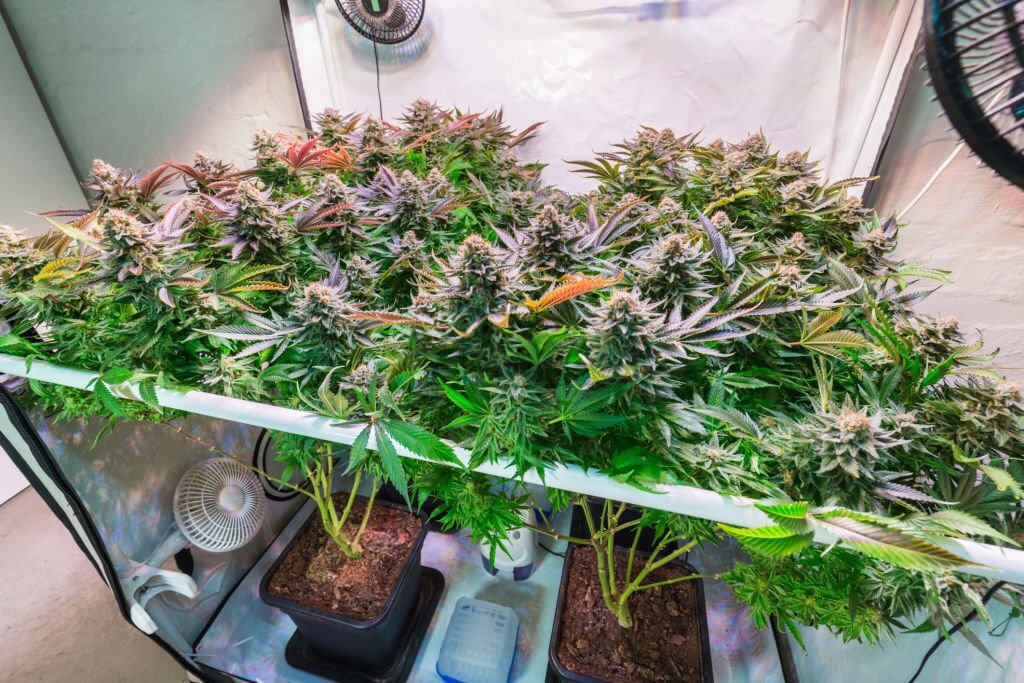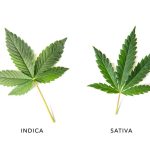🔥 Website for Sale - Contact Us
An indoor grow tent kit is an essential component for those looking to delve into the world of indoor cannabis cultivation. One of the primary reasons behind the rising popularity of grow tents is the level of control they offer. With a grow tent, you can easily regulate critical factors like light, temperature, and humidity. Grow tents also provide an enclosed space, helping to contain odors, reduce the risk of pests, and protect your plants from external contaminants.
Another significant advantage of using a grow tent is the ability to grow cannabis year-round. Outdoor cultivation is often subject to the limitations of weather and seasonal changes, while grow tents provide a controlled environment that can be maintained consistently, regardless of external conditions. This allows for multiple harvests and the flexibility to grow your favorite strains whenever you please.
1. Understanding Grow Tents: The Basics and Benefits
An Overview of Grow Tents and Their Key Components
Grow tents are specifically designed enclosures that provide an ideal environment for indoor cannabis cultivation. They come in various sizes and styles, making them suitable for growers with different needs and space constraints.
A. Frame and Structure: The frame of a grow tent is typically made of metal or plastic poles, which form a sturdy structure to support the tent’s fabric covering and any additional equipment, such as grow lights and ventilation systems. Some grow tents also include adjustable height extensions to accommodate taller plants or increase the distance between the plants and the light source.
B. Fabric Covering: The fabric covering of a grow tent serves as the enclosure that contains your growing environment. Most grow tents are made of heavy-duty, lightproof fabric to prevent light leakage and ensure a consistent light cycle for your plants. The interior walls of the grow tent are usually lined with a reflective material, such as Mylar or white poly, to maximize light exposure and promote even growth.
C. Ventilation Ports: Proper air circulation is essential for maintaining a healthy environment for your cannabis plants. Grow tents come equipped with multiple ventilation ports, which allow you to connect exhaust fans, air filters, and ducting to manage temperature, humidity, and air exchange. Some tents also feature adjustable mesh vents for passive airflow and odor control.
D. Light Hanging System: Grow tents are designed with built-in light hanging systems, typically consisting of horizontal support bars and adjustable straps or hooks. These systems allow you to easily hang your grow lights at the optimal height and position for your plants, ensuring they receive adequate light coverage throughout their growth cycle.
E. Waterproof Floor Tray: To protect your floors and make cleaning easier, grow tents often include a removable, waterproof floor tray. This tray catches excess water and nutrient runoff, preventing spills and potential damage to your growing area.
Advantages of Using Grow Tents for Indoor Cannabis Cultivation
Here are the key benefits of using grow tents for your cannabis garden:
Environmental Control: Grow tents allow you to create a controlled environment, enabling you to adjust factors like temperature, humidity, and light exposure to suit the specific needs of your cannabis plants. This level of control can lead to healthier plants, higher yields, and improved potency.
Pest and Contaminant Protection: The enclosed design of a grow tent helps protect your plants from pests and contaminants commonly found in outdoor growing environments.
Light Optimization: Grow tents are designed with reflective interior walls that help maximize light exposure, ensuring your plants receive consistent and even illumination. This efficient use of light can result in better growth, increased yields, and reduced energy consumption.
Odor Containment: The enclosed structure of a grow tent, combined with the use of carbon filters in your ventilation system, can effectively contain and neutralize odors associated with cannabis cultivation. This feature is especially beneficial for growers looking to maintain a discreet and low-profile growing operation.
Space Efficiency: Grow tents come in various sizes, making them suitable for indoor growers with limited space or specific spatial requirements. The compact design of grow tents allows you to optimize your growing area and efficiently utilize the available space.
Discreet Growing: For those who want to maintain the privacy or comply with local regulations, grow tents offer a discreet solution for indoor cannabis cultivation. Their inconspicuous design can easily blend into your living space without drawing unwanted attention.
Easy Setup and Maintenance: Grow tents are designed for easy assembly and disassembly, making them a convenient option for indoor cannabis growers. Their modular design also simplifies maintenance tasks such as cleaning and adjusting equipment.
2. Sizing It Up: How to Choose the Right Grow Tent Size
Factors to Consider When Selecting the Appropriate Grow Tent Size
Selecting an appropriately sized grow tent will help ensure your plants have enough space to grow and develop properly. Here are some key factors to consider when determining the ideal grow tent size:
Growing Method: Your chosen growing method will also impact the size of the grow tent you require. The use of training techniques such as low-stress training (LST) or the screen of green (SCROG) method will influence the amount of space needed for each plant.
Available Space: Before selecting a grow tent, it’s essential to consider the amount of available space in your growing area. Be sure to measure the dimensions of your intended growing space to ensure the grow tent you choose will fit comfortably. Don’t forget to account for additional equipment such as fans, filters, and lighting systems that may require extra space.
Lighting System: The type of lighting system you plan to use will also influence the size of the grow tent you need. Different lighting systems have varying coverage areas and heat outputs. It’s essential to match your grow tent size with the appropriate lighting system to ensure your plants receive adequate light coverage and maintain optimal temperature and humidity levels.
Plant Height: Cannabis plants can vary significantly in height, depending on the strain and growing method. It’s crucial to select a grow tent with enough vertical space to accommodate your plants’ full height, as well as the necessary distance between the plants and the grow lights. Some grow tents come with adjustable height extensions, which can be helpful for taller plants or varying the distance between the plants and the light source.
Tips for Calculating Grow Space and Managing Plant Density
Estimating Space per Plant: As a general rule of thumb, allocate at least 1-2 square feet per plant for small to medium-sized strains and 2-4 square feet for larger strains.
Consider Plant Training Techniques: Plant training techniques, such as low-stress training (LST) and the screen of green (SCROG) method, can help you maximize the use of your grow space and improve your plant’s overall health and yield. These techniques involve manipulating the growth pattern of your plants to create a more even canopy and increase light exposure.
Factor in Equipment and Walkways: When calculating your required grow space, remember to account for the additional space needed for equipment, such as grow lights, fans, and filters. It’s also essential to factor in walkways and access points for easy maintenance and care of your plants. Be sure to leave enough space for you to move around comfortably and tend to your plants as needed.
Vertical Space Considerations: Don’t forget to consider the vertical space in your grow tent when calculating grow area. Some grow tents come with adjustable height extensions, which can be helpful for taller plants or varying the distance between the plants and the light source.
This will allow you to scale your growing operation over time without the need for a complete overhaul of your grow tent setup.
3. Lighting Your Garden: Choosing the Perfect Grow Light for Your Tent Kit
An Introduction to Various Grow Light Options (LED, HID, and Fluorescent Lights)
In this section, we will introduce you to three popular grow light options: LED, HID, and fluorescent lights.
LED (Light Emitting Diode) Grow Lights: LED grow lights are popular because of their energy efficiency, long lifespan, and low heat output. These lights are available in a range of spectrums, allowing you to finetune the light wavelengths. Some LED lights even come with adjustable spectrum settings, making it easy to switch between vegetative and flowering stages. While LED lights can be more expensive up front, their lower operating costs and longer lifespans often result in long-term savings.
Pros:
- Energy-efficient
- Low heat output
- Long lifespan
- Customizable spectrum options
Cons:
- Higher initial cost
HID (High-Intensity Discharge) Grow Lights: HID grow lights, which include both Metal Halide (MH) and High-Pressure Sodium (HPS) bulbs, have been a popular choice among cannabis growers for years. MH bulbs are known for their blue light spectrum, which is ideal for the vegetative growth stage, while HPS bulbs emit a red light spectrum, better suited for the flowering stage. HID lights are powerful and can produce high yields; however, they also generate a significant amount of heat and require additional ventilation to maintain optimal temperature levels.
Pros:
- High light intensity
- Proven track record for cannabis growth
- Suitable for both vegetative and flowering stages (with appropriate bulb types)
Cons:
- Higher heat output
- Higher energy consumption compared to LED lights
- Shorter lifespan than LED lights
Fluorescent Grow Lights: Fluorescent grow lights, such as Compact Fluorescent Lights (CFLs) and T5 tubes, are an affordable option for novice growers or those with limited space. These lights emit a balanced spectrum of light, making them suitable for both the vegetative and flowering stages. However, fluorescent lights are less powerful than HID or LED lights and may produce lower yields. They are best suited for small-scale growing operations or as supplemental lighting in combination with other light sources.
Pros:
- Affordable
- Low heat output
- Suitable for both vegetative and flowering stages
Cons:
- Lower light intensity compared to HID and LED lights
- Lower yields compared to HID and LED lights
- How to Match Your Grow Light Choice with Your Grow Tent Size and Requirements
Matching your grow light choice with your grow tent size and requirements ensures that your plants receive the appropriate light coverage and intensity. Here are tips on how to match the grow light with your grow tent:
Calculate Your Light Coverage Area: The first step in matching your grow light to your grow tent size is calculating the light coverage area. Most grow light manufacturers provide information on the recommended coverage area for their products. Use this information to determine if a specific grow light will provide sufficient coverage for your grow tent size. Ensure that the grow light covers the entire canopy of your plants to promote even growth and prevent light deprivation.
Consider Light Intensity and Penetration: Different grow lights vary in their light intensity and penetration capabilities. HID lights, for example, are known for their high light intensity but may require additional cooling due to the heat they generate. LED lights, on the other hand, offer lower heat output and customizable spectrum options but can be more expensive upfront. Consider the light intensity and penetration capabilities of each grow light option and how they align with your grow tent size and plant density.
Account for Heat Output: Heat output is a crucial factor to consider when matching your grow light choice with your grow tent size. Some grow lights, such as HID lights, generate a significant amount of heat and may require additional ventilation to maintain optimal temperature levels. LED lights, on the other hand, produce less heat and may be more suitable for smaller grow tents with limited ventilation options. Choose a grow light that is compatible with your grow tent’s size and cooling capabilities to prevent heat stress and other temperature-related issues.
Plan for Future Expansion: If you plan to expand your cannabis garden in the future, it’s essential to choose a grow light that can accommodate additional plants or be easily upgraded. Modular LED lighting systems, for example, can be easily expanded or adjusted, making them an ideal option for growers planning to scale operations.
4. Optimal Ventilation: Keeping Your Cannabis Happy and Healthy
The Importance of Proper Ventilation and Air Circulation in Grow Tents
Good air circulation helps regulate temperature and humidity levels, prevents mold and pests, and promotes healthy plant growth. In this section, we will discuss the importance of proper ventilation and air circulation in grow tents and provide tips for optimizing these factors.
CO2 Exchange: Plants require carbon dioxide (CO2) for photosynthesis, the process by which they convert light into energy. Proper air circulation ensures that fresh CO2-rich air is continuously circulated throughout your grow tent, providing your plants with the necessary CO2 for optimal growth. Additionally, good ventilation helps remove excess oxygen produced during photosynthesis, maintaining an ideal balance of gases within your grow tent.
Prevention of Mold and Pests: Stagnant air and high humidity levels can create the perfect environment for mold, mildew, and pests to thrive. Good air circulation and ventilation help reduce the risk of these issues by keeping the air fresh and dry, preventing the buildup of moisture, and deterring pests from establishing a foothold in your grow tent.
Strengthening Plant Stems: Proper air circulation also plays a role in strengthening your cannabis plants’ stems. When plants are exposed to gentle air movement, they respond by developing stronger and thicker stems to support their growth. This results in healthier and more robust plants, which are better equipped to support heavy buds during the flowering stage.
Tips for Optimizing Ventilation and Air Circulation in Grow Tents:
Use Exhaust Fans and Intake Vents: Exhaust fans and intake vents are crucial for maintaining proper air circulation within your grow tent. Install an exhaust fan at the top of your grow tent to remove warm, stale air, and an intake vent near the bottom to draw in fresh, cool air. This creates a consistent flow of air that helps regulate temperature and humidity levels.
Utilize Oscillating Fans: Oscillating fans help distribute air evenly throughout your grow tent, ensuring that all plants receive adequate airflow. Place one or more oscillating fans within your grow tent, making sure they are directed at the canopy level and not directly at the plants, to prevent wind stress.
Regularly Monitor Temperature and Humidity: Invest in a quality thermometer and hygrometer to monitor the temperature and humidity levels within your grow tent. Regularly check these levels to ensure they remain within the ideal range for your plants and make adjustments to your ventilation system as needed.
Types of Ventilation Systems and How to Choose the Best One for Your Tent Kit
Passive Ventilation System: A passive ventilation system relies on the natural flow of air through intake vents and exhaust openings. Passive ventilation systems may not be as effective in maintaining optimal temperature and humidity levels as other systems, particularly in larger grow tents or those with high heat output grow lights.
Pros:
- Simple and affordable
- No mechanical components
Cons:
- Less effective in larger grow tents or those with high heat output lights
Active Ventilation System: An active ventilation system uses mechanical components, such as exhaust fans and intake fans, to actively move air in and out of the grow tent. This type of system is more effective at maintaining optimal temperature and humidity levels, especially in larger grow tents or those with high heat output lights.
Pros:
- Effective at maintaining optimal temperature and humidity levels
- Suitable for larger grow tents or those with high heat output lights
Cons:
- More expensive
- Requires more maintenance
Climate Control System: A climate control system is an advanced ventilation system that integrates temperature, humidity, and CO2 control into a single unit. These systems often include automated controls and sensors, allowing you to maintain the ideal growing conditions with minimal effort. Climate control systems are the most expensive option but offer the greatest level of control and precision over your grow tent’s environment.
Pros:
- Integrated temperature, humidity, and CO2 control
- Automated controls and sensors
Cons:
- Most expensive option
How to Choose the Best Ventilation System
Evaluate Your Heat Output: The heat output from your grow lights and other equipment within your grow tent also impacts the type of ventilation system needed. Grow tents with high heat output lights or equipment may require active ventilation systems or climate control systems to effectively regulate temperature and humidity levels.
Assess Your Budget: Budget is another important consideration when choosing a ventilation system. Passive ventilation systems are the most affordable option but may not be suitable for larger grow tents or those with high heat output lights. Active systems and climate control systems offer improved performance but come with higher price tags.
Determine Your Level of Control: Consider how much control you want over your grow tent’s environment when selecting a ventilation system.
Types of Ventilation Systems and How to Choose the Best One for Your Tent Kit
Passive Ventilation System: A passive ventilation system relies on the natural flow of air through intake vents and exhaust openings. Passive ventilation systems may not be as effective in maintaining optimal temperature and humidity levels as other systems, particularly in larger grow tents or those with high heat output grow lights.
Pros:
- Simple and affordable
- No mechanical components
Cons:
- Less effective in larger grow tents or those with high heat output lights
Active Ventilation System: An active ventilation system uses mechanical components, such as exhaust fans and intake fans, to actively move air in and out of the grow tent. This type of system is more effective at maintaining optimal temperature and humidity levels, especially in larger grow tents or those with high heat output lights.
Pros:
- Effective at maintaining optimal temperature and humidity levels
- Suitable for larger grow tents or those with high heat output lights
Cons:
- More expensive
- Requires more maintenance
Climate Control System: A climate control system is an advanced ventilation system that integrates temperature, humidity, and CO2 control into a single unit. These systems often include automated controls and sensors, allowing you to maintain the ideal growing conditions with minimal effort. Climate control systems are the most expensive option but offer the greatest level of control and precision over your grow tent’s environment.
Pros:
- Integrated temperature, humidity, and CO2 control
- Automated controls and sensors
Cons:
- Most expensive option
How to Choose the Best Ventilation System:
Consider Your Grow Tent Size: The size of your grow tent plays a significant role in determining the most appropriate ventilation system. Larger grow tents typically require more powerful ventilation systems, such as active systems or climate control systems, to maintain optimal temperature and humidity levels.
Evaluate Your Heat Output: The heat output from your grow lights and other equipment within your grow tent also impacts the type of ventilation system needed. Grow tents with high heat output lights or equipment may require active ventilation systems or climate control systems to effectively regulate temperature and humidity levels.
5. Grow Mediums: Soil vs. Hydroponics in Your Grow Tent Kit
A Comparison of Soil and Hydroponic Growing Methods
The two most popular growing methods for indoor cannabis cultivation are soil-based and hydroponic systems.
Soil-Based Growing: Soil-based growing is a traditional method that involves planting your cannabis plants directly in a soil mix. This method is generally considered easier for beginners, as it provides a more forgiving growing environment with a natural buffer against fluctuations in pH and nutrient levels.
Pros:
- Easier for beginners
- Natural buffer against pH and nutrient fluctuations
- Mimics the plants’ natural environment
- Generally less expensive to set up
Cons:
- Slower growth rate compared to hydroponics
- More prone to pests and diseases
- Less control over nutrient levels
- Requires more space and can be messier
Hydroponic Growing: Hydroponic growing is a soil-less method in which plants are grown in a nutrient-rich water solution, typically supported by an inert medium such as coco coir, perlite, or rockwool. Hydroponic systems allow for greater control over nutrient levels and faster growth rates compared to soil-based growing. However, they can be more complex and less forgiving for beginners.
Pros:
- Faster growth rates and higher yields
- Greater control over nutrient levels
- Less prone to pests and diseases
- Cleaner and more space-efficient
Cons:
- More complex and less forgiving for beginners
- Requires a higher initial investment
- Can be more challenging to maintain ideal pH and nutrient levels
- May require additional equipment and expertise
Which Method is Right for Your Grow Tent?
Soil-based growing methods are more beginner-friendly and offer a natural environment for your cannabis plants, while hydroponic systems provide faster growth, greater control, and space efficiency.
Tips for Deciding Which Growing Medium is Best Suited for Your Indoor Grow Tent Kit
Assess Your Experience Level: Consider your experience level when selecting a growing medium. Beginners may find soil-based mediums more forgiving and easier to work with, while more experienced growers might opt for soilless mediums or hydroponic systems that offer greater control and potentially higher yields.
Evaluate Your Time Commitment: Different growing mediums require varying degrees of time and attention. Soil-based mediums typically require less frequent watering and nutrient adjustments, whereas hydroponic systems and soilless mediums demand more diligent monitoring and maintenance. Consider how much time you can commit to managing your grow tent when choosing a growing medium.
Consider Your Budget: The cost of your growing medium is another essential factor to consider. Soil-based mediums are generally more affordable and require a lower initial investment. In contrast, hydroponic systems and soilless mediums often have higher upfront costs due to the need for specialized equipment and materials.
Analyze Your Space Constraints: Space constraints can play a significant role in determining the best grow medium for your indoor grow tent kit. Hydroponic systems and soilless mediums can be more space-efficient, making them ideal for growers with limited room. On the other hand, soil-based grows typically require larger containers and more space.
Factor in Plant Nutrition: The nutrient requirements of your cannabis plants are an essential aspect to consider when choosing a growing medium. Some mediums, such as soil, come pre-loaded with nutrients, while others, like hydroponic systems, require the grower to manually add nutrients. Ensure that you are comfortable with the level of nutrient management your chosen medium demands.
6. Essential Accessories: Enhancing Your Indoor Grow Tent Kit Experience
A Rundown of Essential Grow Tent Accessories
To create the ideal environment for your cannabis plants and optimize their growth, there are several essential grow tent accessories you should consider investing in. These accessories can help you better manage your grow tent’s environment, and maximize your yields. In this section, we will provide a rundown of essential grow tent accessories, such as timers, thermometers, and trellis systems.
Timers: Timers are a crucial accessory for maintaining a consistent light schedule in your grow tent. There are various types of timers available, including mechanical, digital, and smart timers with app integration.
Thermometers and Hygrometers: Monitoring temperature and humidity levels within your grow tent is essential for maintaining the ideal growing conditions for your cannabis plants. A thermometer measures the ambient temperature, while a hygrometer measures humidity levels. Many devices combine both functionalities into a single unit.
Trellis Systems: Trellis systems provide support for your cannabis plants, promoting even growth and light distribution. They can also help manage plant height and prevent branches from breaking under the weight of heavy buds. There are several types of trellis systems available, including traditional bamboo stakes, metal cage structures, and flexible plant ties.
Clip-on Fans: Air circulation is essential for maintaining a healthy environment within your grow tent. Clip-on fans can help distribute fresh air evenly throughout your tent, preventing the formation of mold and mildew, and minimizing the risk of pests. They can also help to strengthen plant stems by creating a gentle breeze that mimics natural outdoor conditions.
pH and PPM Meters: For growers using hydroponic systems or soilless mediums, monitoring pH and nutrient levels is crucial for maintaining optimal plant health. pH meters measure the acidity or alkalinity of your nutrient solution, while PPM (parts per million) meters measure the concentration of nutrients. Proper pH and nutrient management can help prevent nutrient lockout and ensure your plants have access to the necessary elements for optimal growth.
Odor Control: To manage the strong aroma produced by cannabis plants, especially during the flowering stage, you may want to invest in odor control accessories. Carbon filters and inline fans can effectively neutralize and remove odors from your grow tent, ensuring a discreet and pleasant growing experience.





